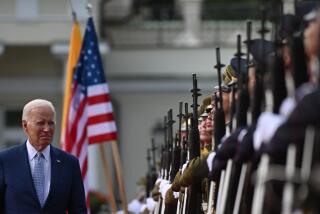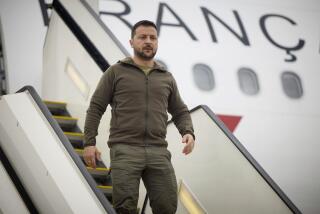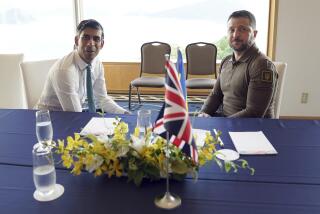Summit Scorecard
The developments: After months of promising, President Bush announced that the United States is granting most-favored-nation trade status to the Soviet Union, giving it the same low tariffs that it allows other U.S. trading partners. But his announcement was overshadowed by political sparring between Soviet President Mikhail S. Gorbachev and Russian President Boris N. Yeltsin, who both vied for the limelight.
* Bush met with Yeltsin for 45 minutes, giving an added political boost to the maverick Gorbachev rival.
* Gorbachev and Yeltsin cleared away the last hitch so that Russia can sign the Union Treaty.
Outlook: Soviet relations: How to begin direct ties with the increasingly nationalistic Soviet republics without undermining the authority of Gorbachev’s central government in Moscow. Bush’s ability to walk that tightrope will be tested to the maximum Thursday when he visits the increasingly restive Ukraine.
On tap today: Negotiations will focus on the issues that used to be the entire U.S.-Soviet agenda: arms control and regional conflicts.
* Gorbachev wants to push for a new round of arms talks that would aim for much deeper cuts than those agreed to in the START treaty.
* Bush and his aides, however, are downplaying any such talk.
Quotable: In the U.S., everyone now knows at least two Russian words: glasnost and perestroika. And here, everyone appreciates an English word, democracy. “
--President Bush
By the Numbers: This is the fourth U.S.-Soviet summit since Bush became President, and the eighth meeting between the two men.
* Overall, U.S. Presidents have met their Soviet counterparts 24 times since the first such meeting, between Franklin D. Roosevelt and Josef V. Stalin, in 1943 in Tehran.
* The White House has brought more than 550 staff members to Moscow for this summit.
Remembrances: Every U.S. President since John F. Kennedy has negotiated at least one arms-control treaty with his Soviet counterpart. The first such treaty was designed to eliminate testing of nuclear explosives in the atmosphere. The current treaty is the first that would lead to destruction of long-range nuclear weapons.
More to Read
Sign up for Essential California
The most important California stories and recommendations in your inbox every morning.
You may occasionally receive promotional content from the Los Angeles Times.










